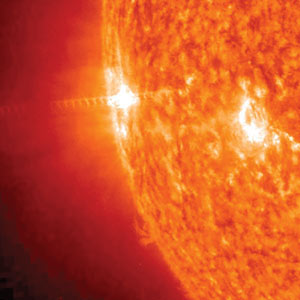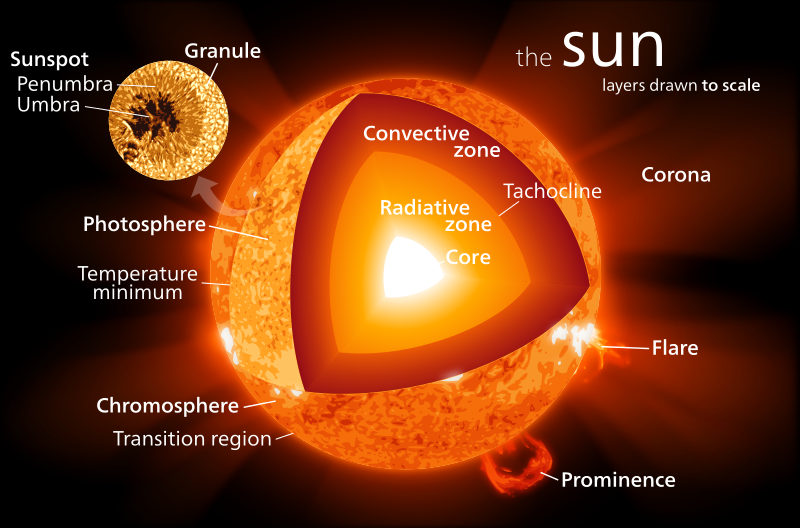
From the Greek helios comes the rare adjective heliac ( / ˈ h iː l i æ k/). The principal adjectives for the Sun in English are sunny for sunlight and, in technical contexts, solar ( / ˈ s oʊ l ər/), from Latin sol – the latter found in terms such as solar day, solar eclipse and Solar System (occasionally Sol system). Indeed, the l-stem survived in Proto-Germanic as well, as * sōwelan, which gave rise to Gothic sauil (alongside sunnō) and Old Norse prosaic sól (alongside poetic sunna), and through it the words for sun in the modern Scandinavian languages: Swedish and Danish sol, Icelandic sól, etc. This is ultimately related to the word for sun in other branches of the Indo-European language family, though in most cases a nominative stem with an l is found, rather than the genitive stem in n, as for example in Latin sōl, ancient Greek ἥλιος ( hēlios), Welsh haul and Czech slunce, as well as (with *l > r) Sanskrit स्वर ( svár) and Persian خور ( xvar). All these words stem from Proto-Germanic * sunnōn. Cognates appear in other Germanic languages, including West Frisian sinne, Dutch zon, Low German Sünn, Standard German Sonne, Bavarian Sunna, Old Norse sunna, and Gothic sunnō. The English word sun developed from Old English sunne. The predominant calendar in use today is the Gregorian calendar which is based upon the standard 16th-century interpretation of the Sun's observed movement as actual movement. The synodic rotation of Earth and its orbit around the Sun are the basis of some solar calendars. The Sun was thought of by some cultures as a deity. The enormous effect of the Sun on Earth has been recognized since prehistoric times. After this, it will shed its outer layers and become a dense type of cooling star known as a white dwarf, and no longer produce energy by fusion, but still glow and give off heat from its previous fusion. It is calculated that the Sun will become sufficiently large to engulf the current orbits of Mercury and Venus, and render Earth uninhabitable in five billion years. When hydrogen fusion in its core has diminished to the point at which the Sun is no longer in hydrostatic equilibrium, its core will undergo a marked increase in density and temperature while its outer layers expand, eventually transforming the Sun into a red giant. This energy, which can take between 10,000 and 170,000 years to escape the core, is the source of the Sun's light and heat. It is thought that almost all stars form by this process.Įvery second, the Sun's core fuses about 600 million tons of hydrogen into helium, and in the process converts 4 million tons of matter into energy.

The central mass became so hot and dense that it eventually initiated nuclear fusion in its core. Most of this matter gathered in the center, whereas the rest flattened into an orbiting disk that became the Solar System. It formed approximately 4.6 billion years ago from the gravitational collapse of matter within a region of a large molecular cloud. As such, it is informally, and not completely accurately, referred to as a yellow dwarf (its light is actually white). The Sun is a G-type main-sequence star (G2V). Roughly three-quarters of the Sun's mass consists of hydrogen (~73%) the rest is mostly helium (~25%), with much smaller quantities of heavier elements, including oxygen, carbon, neon, and iron. Its mass is about 330,000 times that of Earth, comprising about 99.86% of the total mass of the Solar System. The Sun's radius is about 695,000 kilometers (432,000 miles), or 109 times that of Earth.

The Sun radiates this energy mainly as light, ultraviolet, and infrared radiation, and is the most important source of energy for life on Earth. It is a nearly perfect ball of hot plasma, heated to incandescence by nuclear fusion reactions in its core. The Sun is the star at the center of the Solar System. ≈ 370 km/s (relative to the cosmic microwave background) ≈ 20 km/s (relative to average velocity of other stars in stellar neighborhood) ≈ 251 km/s (orbit around the center of the Milky Way) Sun, Sol ( / ˈ s ɒ l/), Sól, Helios ( / ˈ h iː l i ə s/) True-color image taken in 2019 using a solar filter


 0 kommentar(er)
0 kommentar(er)
